Comparison Study of Two Semi-Active Hybrid Energy Storage Systems for Hybrid Electric Vehicle Applications and Their Experimental Validation
Abstract
:1. Introduction
2. The Energy Storage Requirements of Public Transit Hybrid Electric Bus
2.1. ESS Operating Data
2.2. Energy Storage Requirement Statistics
2.2.1. Energy Requirements during Charging/Discharging
2.2.2. Power Demands during Charging/Discharging
3. Characteristics of the Component in Hybrid Energy Storage System
3.1. Specifications of Battery and Supercapacitor
3.2. Efficiency Density and Efficiency Characteristics of Battery and Supercapacitor
4. Comparisons of Two Semi-Active Configurations of Hybrid Energy Storage System
4.1. Reversible Boost DC/DC Converter
4.2. Configurations and Energy Manegement of Semi-Active Hybrid Energy Storage System
4.3. Comparison of Two Configurations
5. Real Vehicle Experiment and Performance Comparison Analysis
5.1. Prototype of Hybrid Energy Storage System for Real Public Transit Hybrid Electric Bus
5.2. Experiments of Real Public Transit Hybrid Electric Bus
6. Conclusions
- (1)
- The SC/battery efficiency is higher than that of battery/SC when the parameters are the same;
- (2)
- In the SC/battery topology, the energy provided by the SC rises with improved total efficiency as the proportion of SC increases;
- (3)
- In the battery/SC topology, the total efficiency cannot be obviously improved with the proportion of SC increasing.
Acknowledgments
Author Contributions
Conflicts of Interest
References
- Somayajula, D.; Meintz, A.; Ferdowsi, M. Designing efficient hybrid electric vehicles. IEEE Veh. Technol. Mag. 2009, 4, 65–72. [Google Scholar] [CrossRef]
- Wang, D.; Coignard, J.; Zeng, T. Quantifying electric vehicle battery degradation from driving vs. vehicle-to-grid services. J. Power Sources 2016, 332, 193–203. [Google Scholar] [CrossRef]
- Kim, Y.; Koh, J.; Xie, Q.; Wang, Y.; Chang, N.; Pedram, M. A scalable and flexible hybrid energy storage system design and implementation. J. Power Sources 2014, 255, 410–422. [Google Scholar] [CrossRef]
- Ostadi, A.; Kazerani, M. A comparative analysis of optimal sizing of battery-only, ultracapacitor-only, and battery–ultracapacitor hybrid energy storage systems for a city bus. IEEE Trans. Veh. Technol. 2015, 64, 4449–4460. [Google Scholar] [CrossRef]
- Zhang, C.; Min, H.; Yu, Y.; Wang, D.; Luke, J.; Opila, D.; Saxena, S. Using CPE function to size capacitor storage for electric vehicles and quantifying battery degradation during different driving cycles. Energies 2016, 9, 903. [Google Scholar] [CrossRef]
- Cao, J.; Emadi, A. A new battery/ultracapacitor hybrid energy storage system for electric, hybrid, and plug-in hybrid electric vehicles. IEEE Trans. Power Electron. 2012, 27, 122–132. [Google Scholar]
- Jimenez-Espadafor, F.J.; Marín, J.J.R.; Villanueva, J.A.B.; García, M.T.; Trujillo, E.C.; Ojeda, F.J.F. Infantry mobility hybrid electric vehicle performance analysis and design. Appl. Energy 2011, 88, 2641–2652. [Google Scholar] [CrossRef]
- Song, Z.; Hofmann, H.; Li, J.; Han, X.; Ouyang, M. Optimization for a hybrid energy storage system in electric vehicles using dynamic programing approach. Appl. Energy 2015, 139, 151–162. [Google Scholar] [CrossRef]
- Hung, Y.-H.; Wu, C.-H. An integrated optimization approach for a hybrid energy system in electric vehicles. Appl. Energy 2012, 98, 479–490. [Google Scholar] [CrossRef]
- Song, Z.Y.; Li, J.Q.; Han, X.B.; Xu, L.F.; Lu, L.G.; Ouyang, M.G.; Hofmann, H. Multi-objective optimization of a semi-active battery/supercapacitor energy storage system for electric vehicles. Appl. Energy 2014, 135, 212–224. [Google Scholar] [CrossRef]
- Qu, X.D.; Wang, Q.N.; Yu, Y.B. Power demand analysis and performance estimation for active-combination energy storage system used in hybrid electric vehicles. IEEE Trans. Veh. Technol. 2014, 63, 3128–3136. [Google Scholar]
- Shen, J.Y.; Dusmez, S.; Khaligh, A. Optimization of sizing and battery cycle life in battery/ultracapacitor hybrid energy storage systems for electric vehicle applications. IEEE Trans. Ind. Inform. 2014, 10, 2112–2121. [Google Scholar] [CrossRef]
- Yu, Y.B.; Liu, X.G.; Min, H.T.; Sun, H.; Xu, L. A novel fuzzy-logic based control strategy for a semi-active battery/super-capacitor hybrid energy storage system in vehicular applications. J. Intell. Fuzzy Syst. 2015, 29, 2575–2584. [Google Scholar] [CrossRef]
- Zhang, C.; Min, H.; Yu, Y.; Wang, Q.; Sun, H. A new method to optimize semiactive hybrid energy storage system for hybrid electrical vehicle by using pe function. Math. Probl. Eng. 2015, 2015, 457303. [Google Scholar] [CrossRef]
- Liang, J.Y.; Zhang, J.L.; Zhang, X.; Yuan, S.F.; Yin, C.L. Energy management strategy for a parallel hybrid electric vehicle equipped with a battery/ultra-capacitor hybrid energy storage system. J. Zhejiang Univ. Sci. A 2013, 14, 535–553. [Google Scholar] [CrossRef]
- Miller, J.M.; Sartorelli, G. Battery and ultracapacitor combinations—Where should the converter go? In Proceedings of the IEEE Vehicle Power and Propulsion Conference (VPPC), Lille, France, 1–3 September 2010; pp. 1–7.
- Liu, S.; Corzine, K.A.; Ferdowsi, M. A new battery/ultracapacitor energy storage system design and its motor drive integration for hybrid electric vehicles. IEEE Trans. Veh. Technol. 2007, 56, 1516–1523. [Google Scholar] [CrossRef]
- Song, Z.; Hofmann, H.; Li, J.; Han, X.; Zhang, X. A comparison study of different semi-active hybrid energy storage system topologies for electric vehicles. J. Power Sources 2015, 274, 400–411. [Google Scholar] [CrossRef]
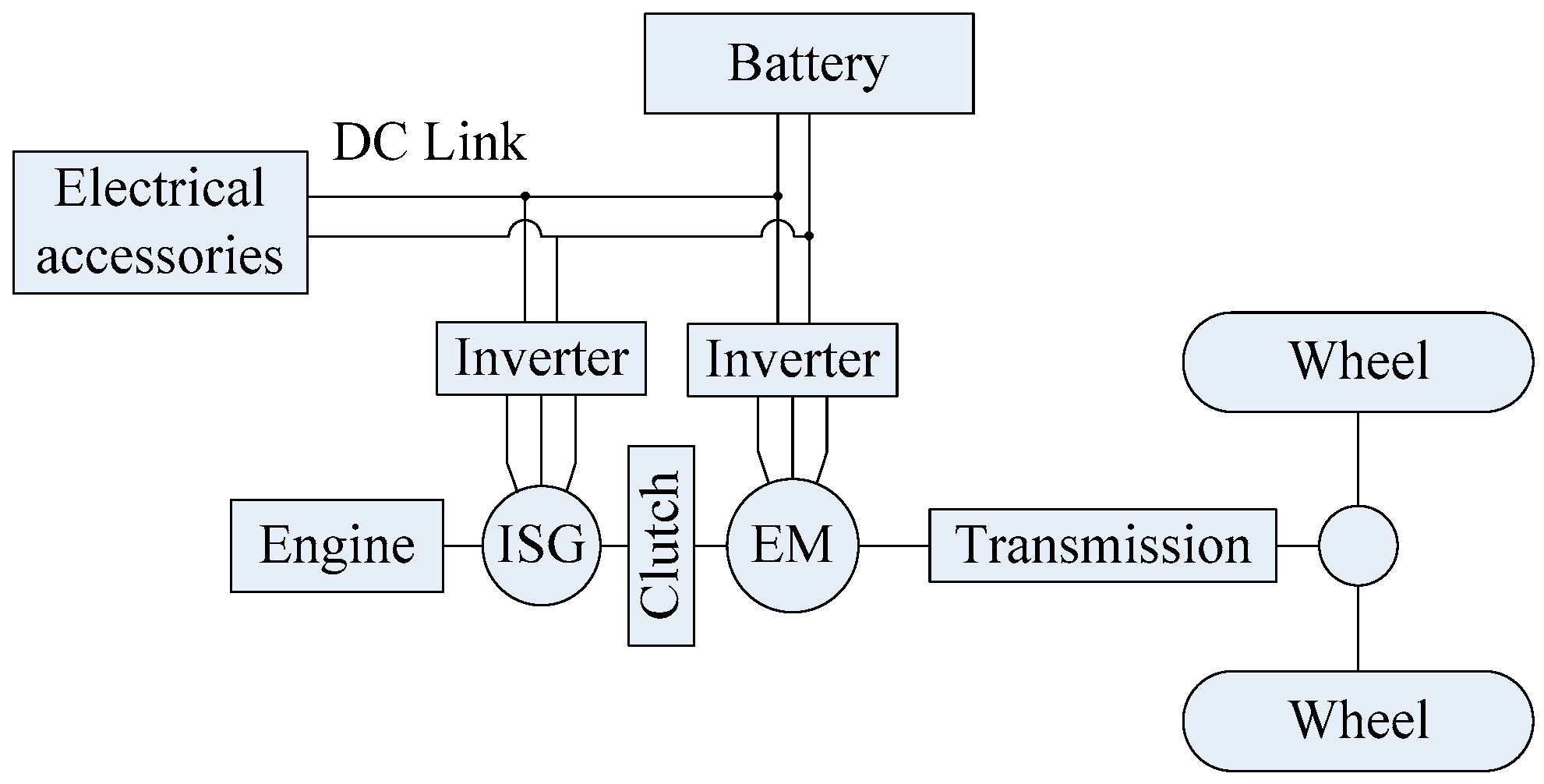
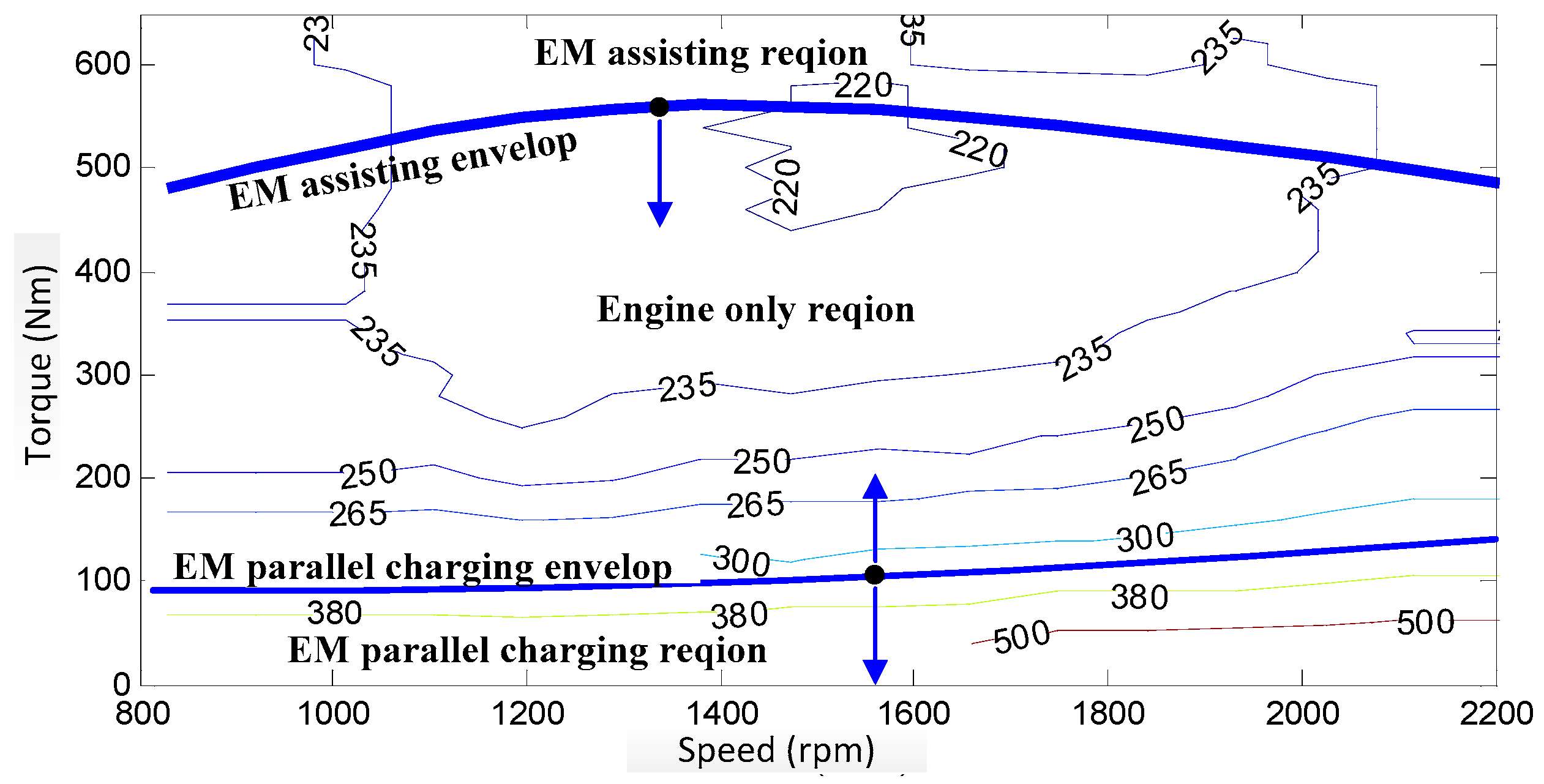
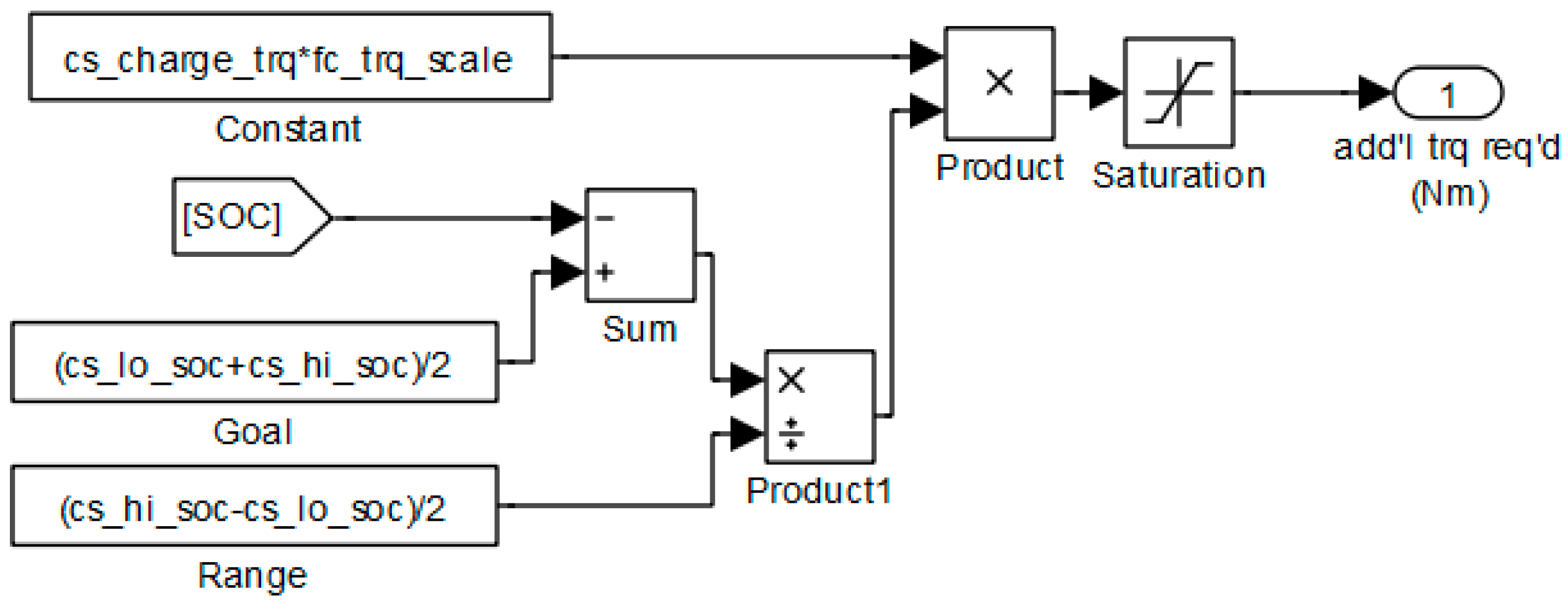


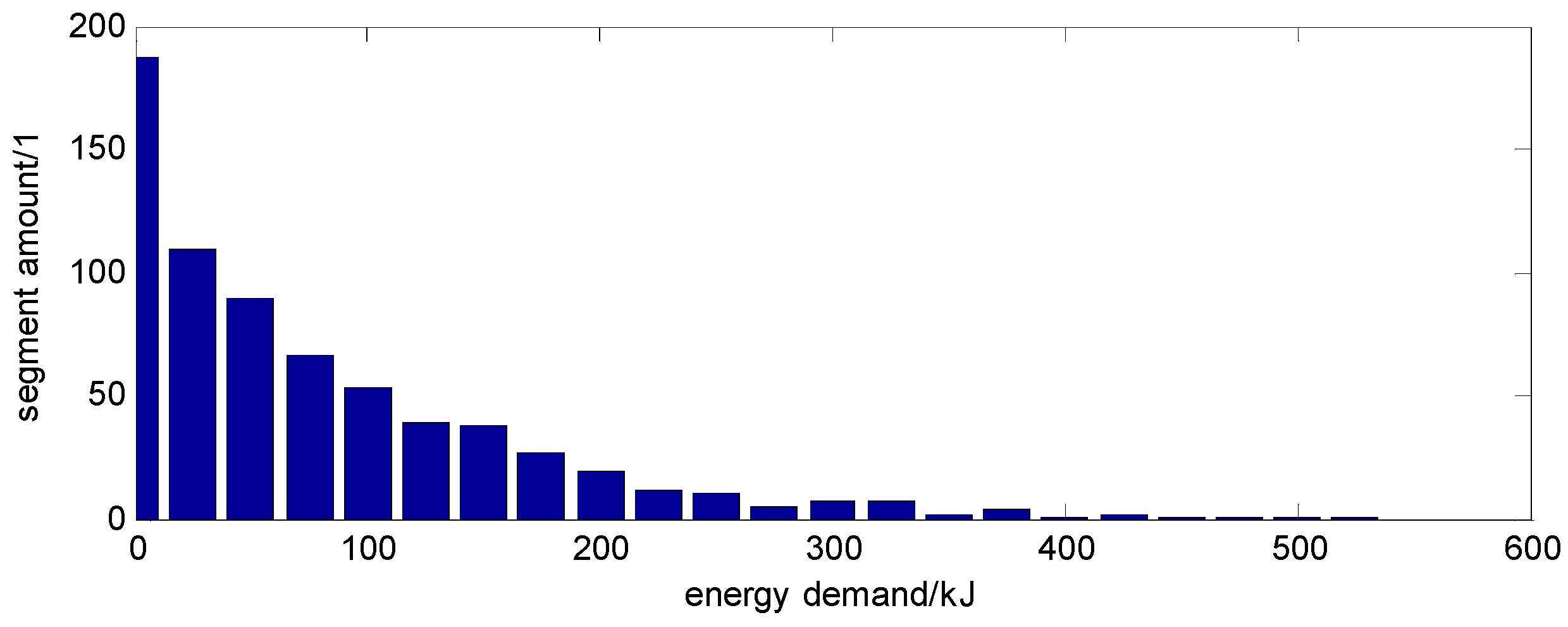
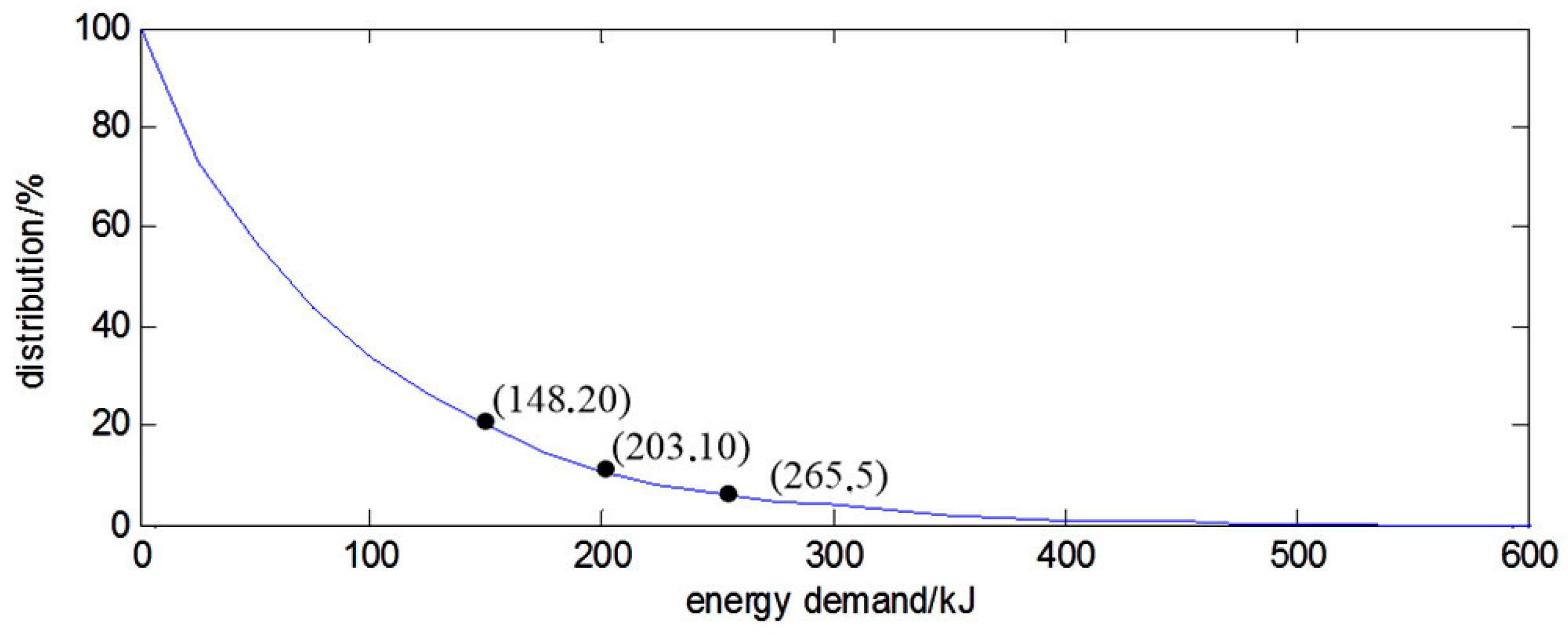
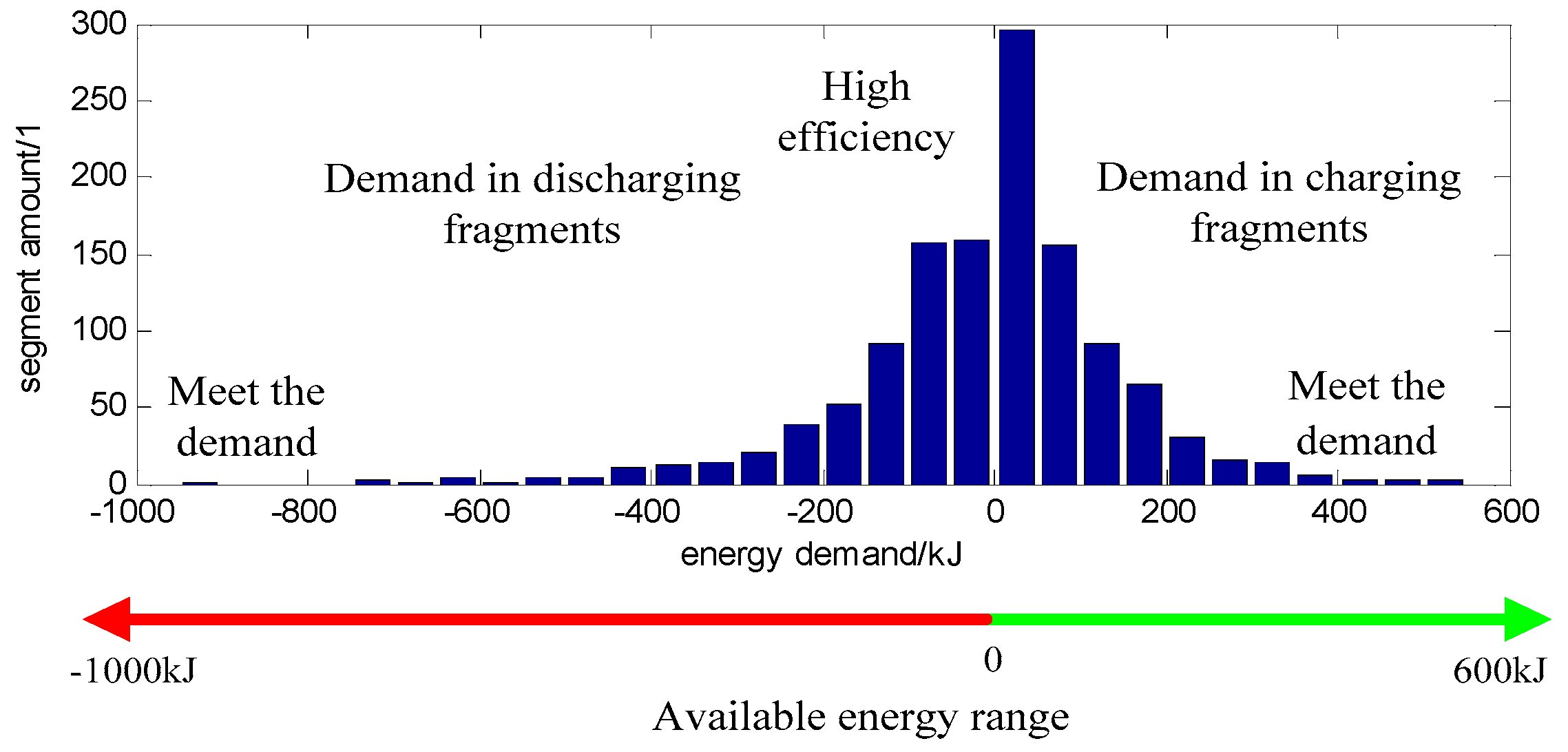
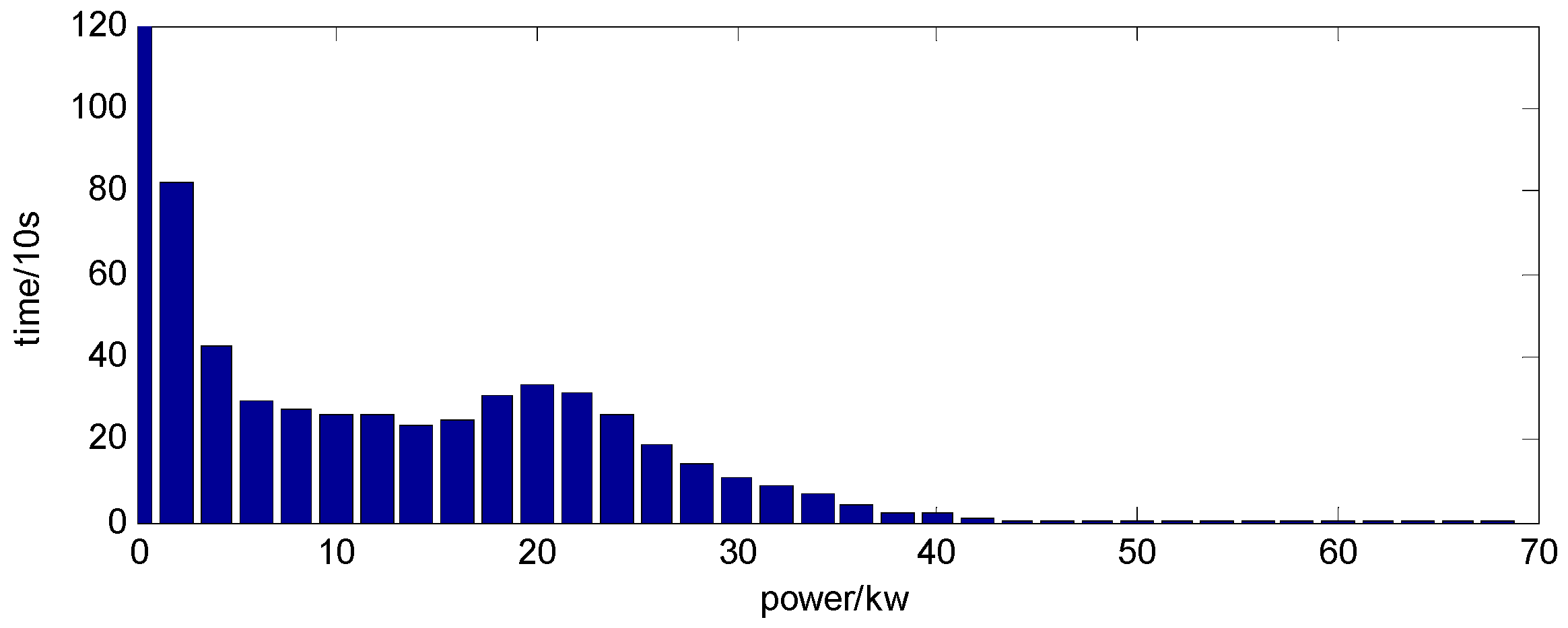
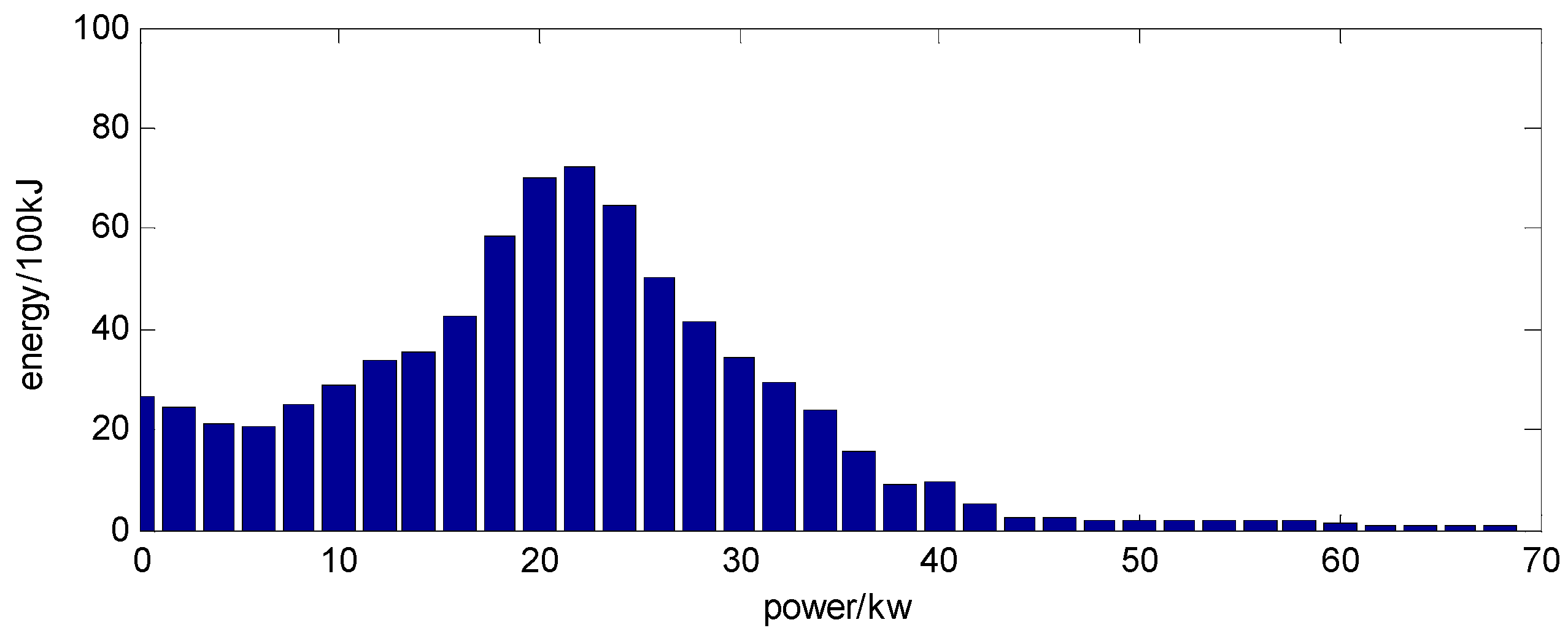
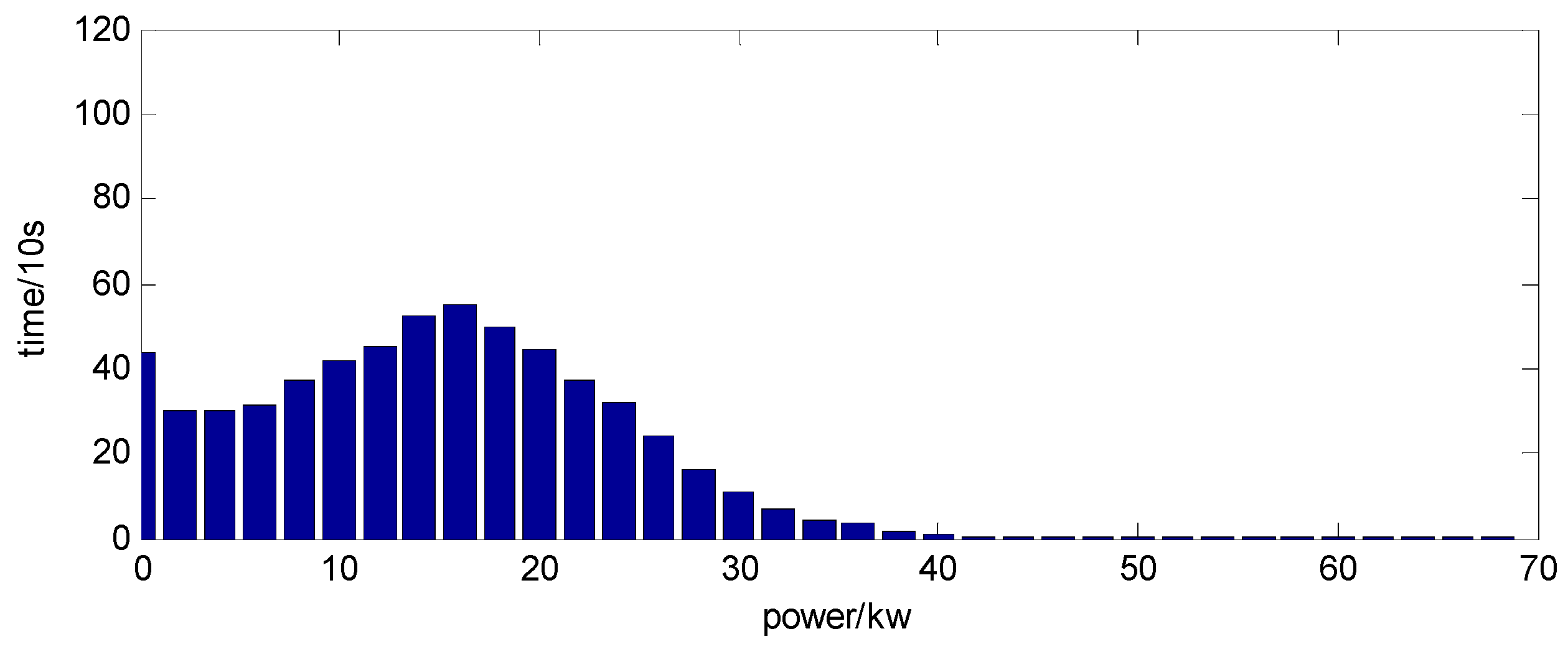
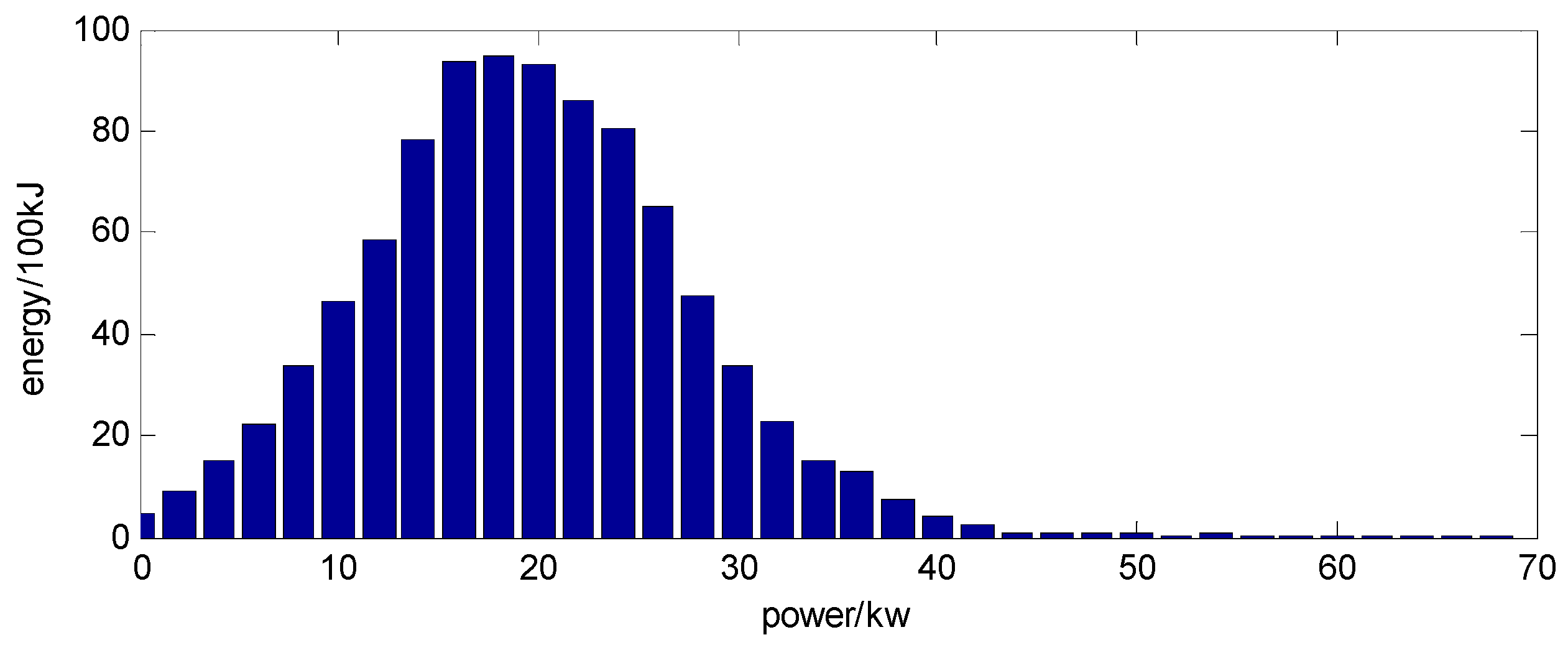
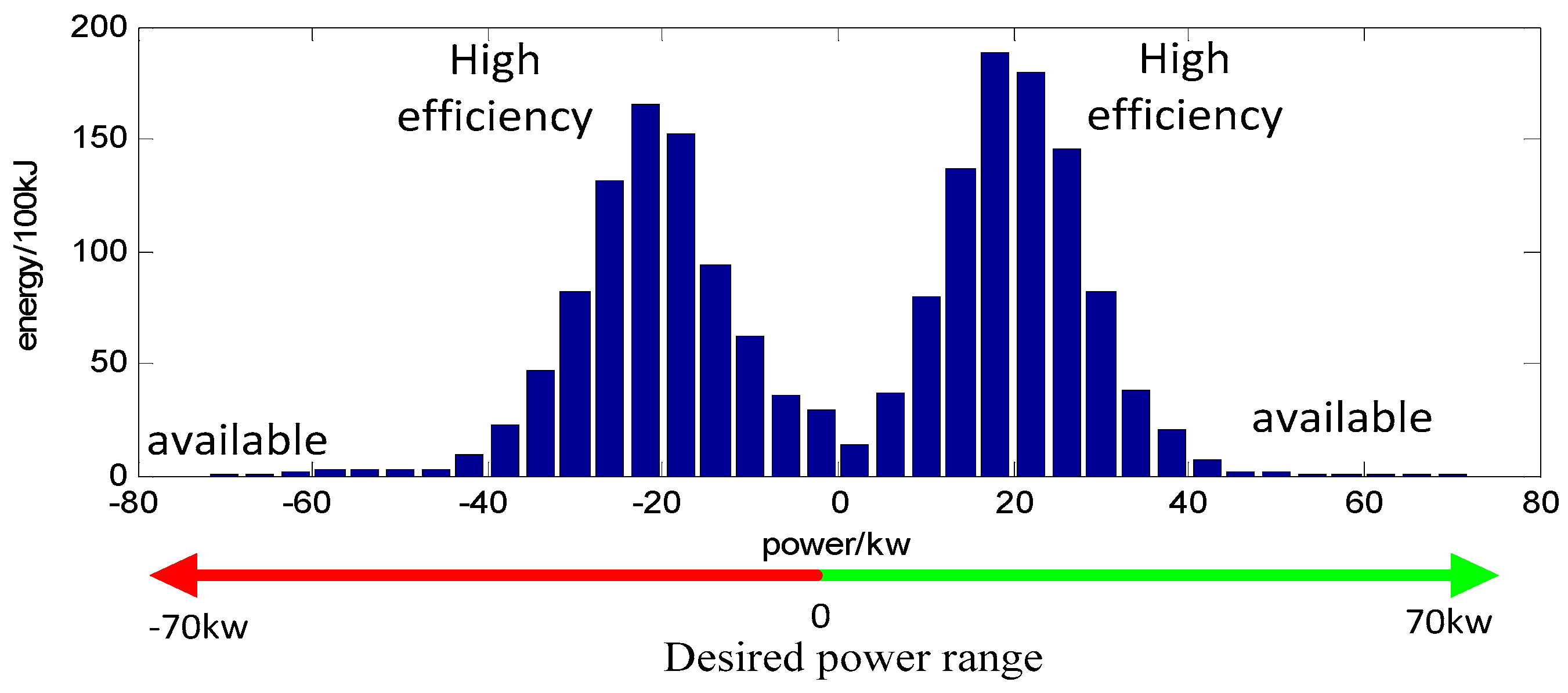
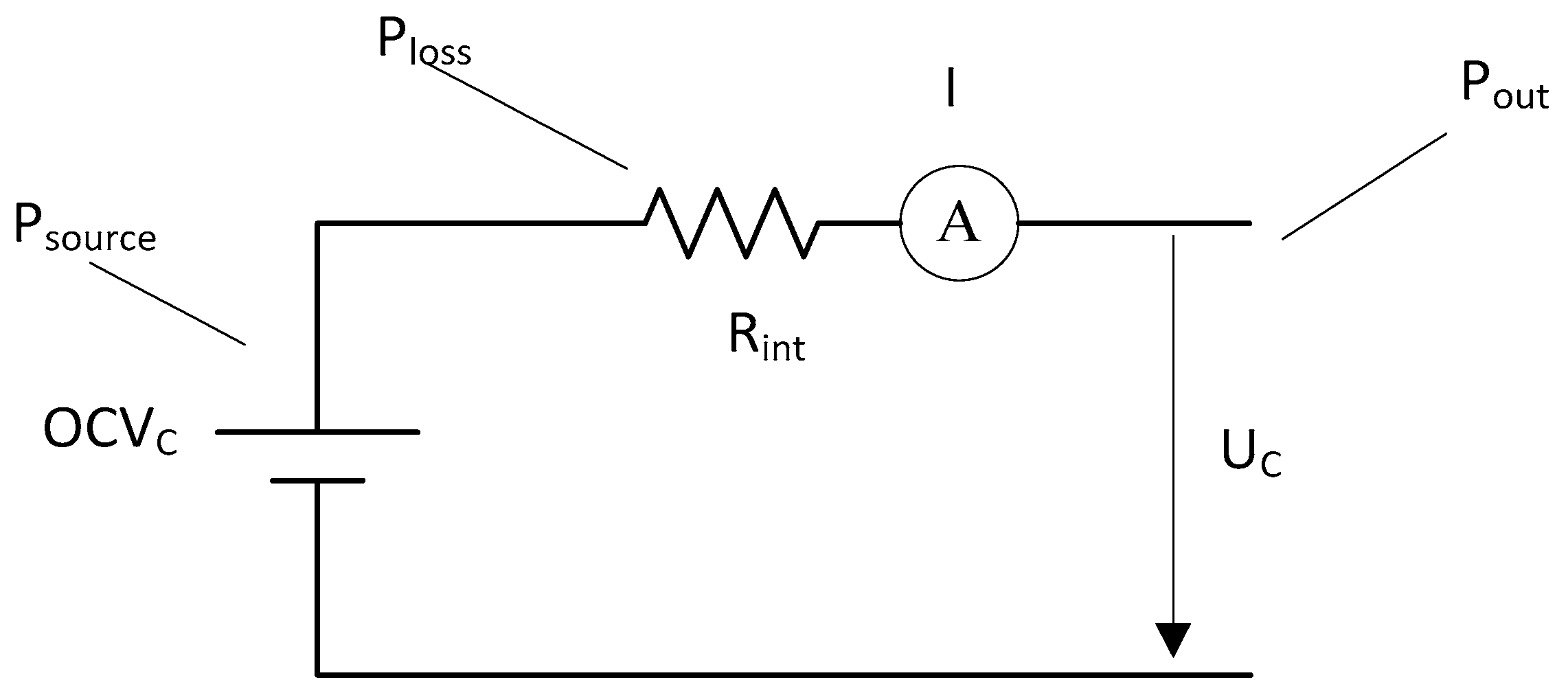
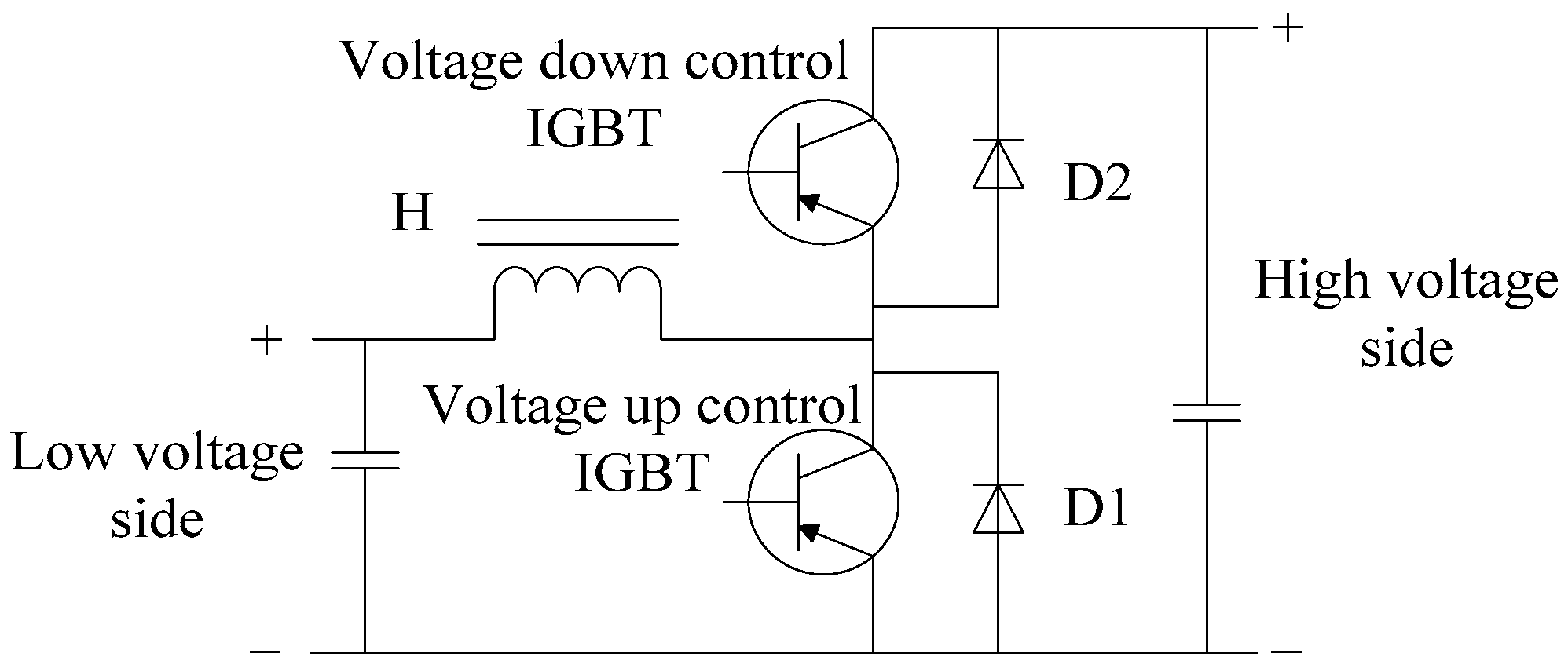
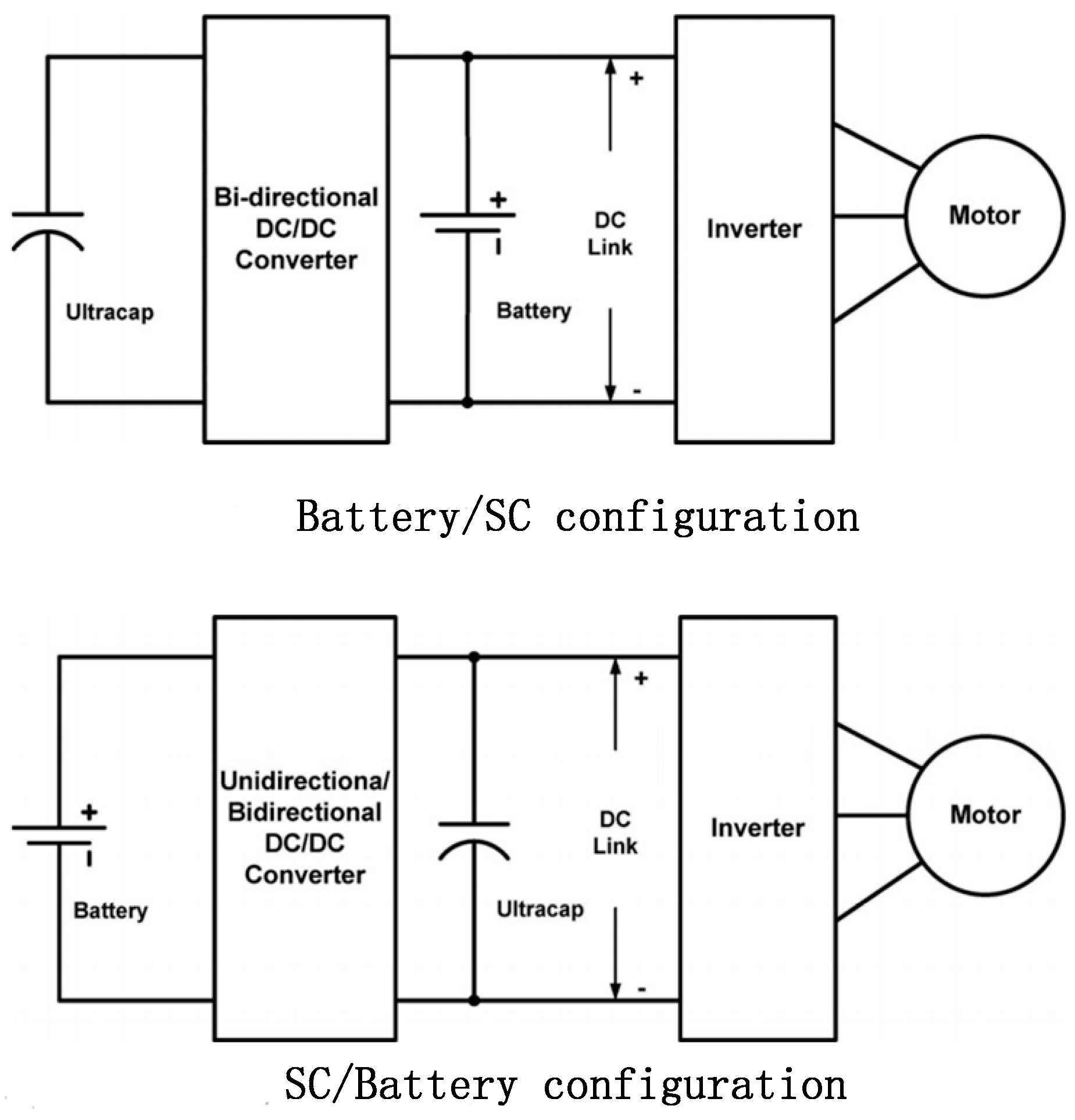
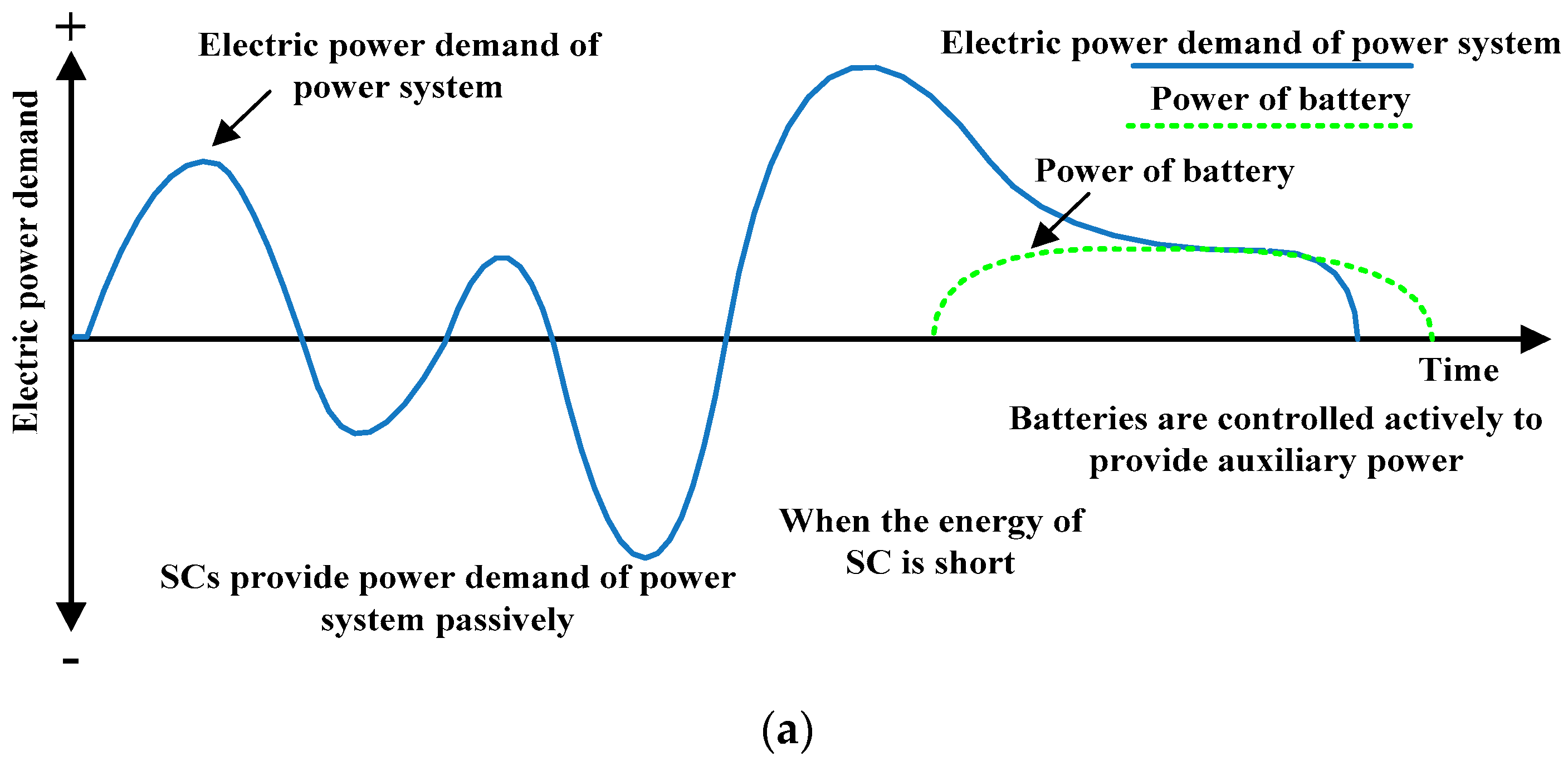
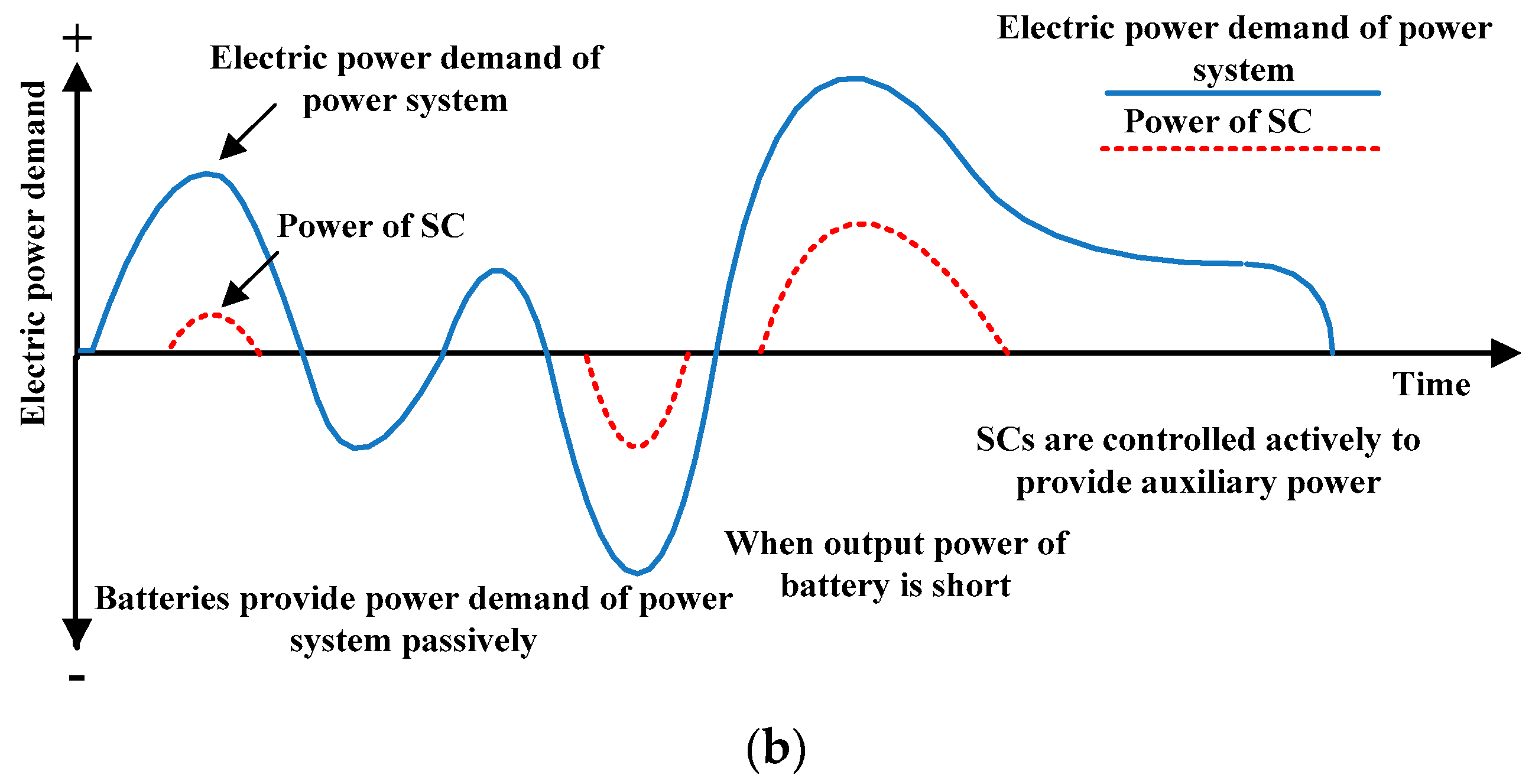

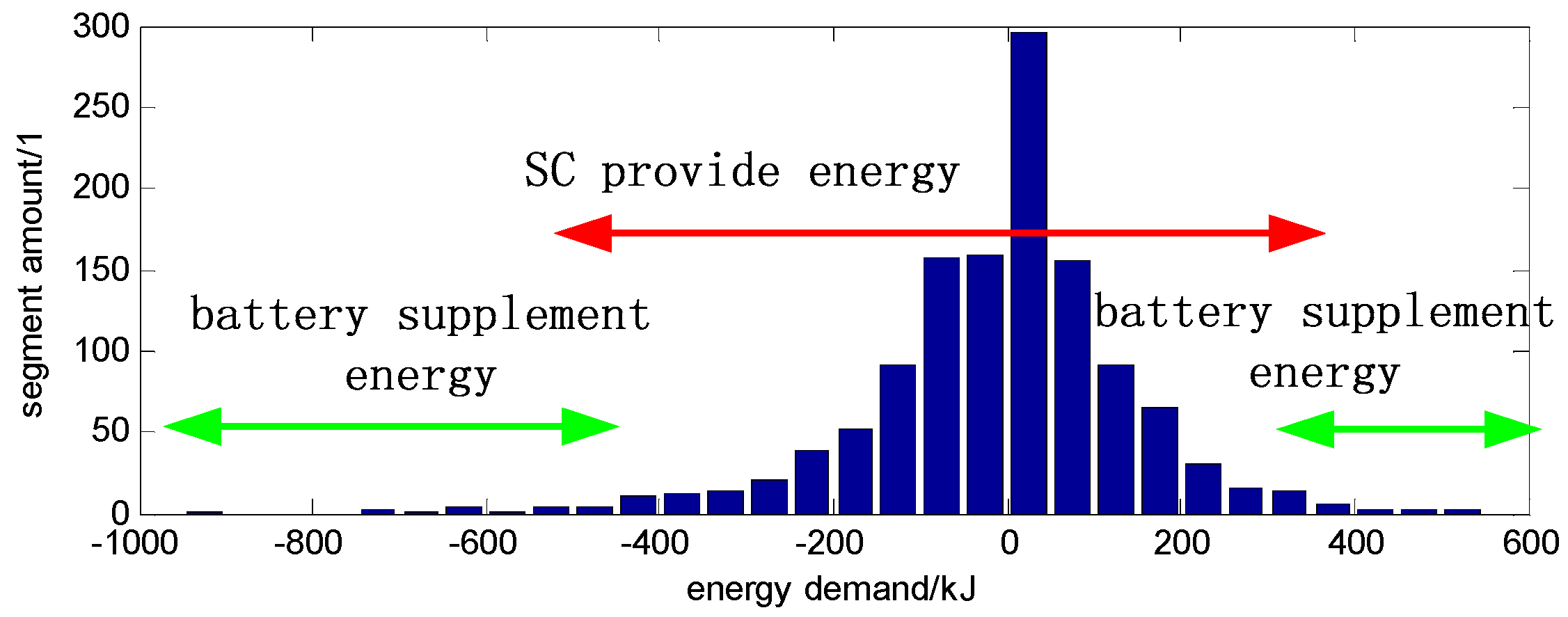
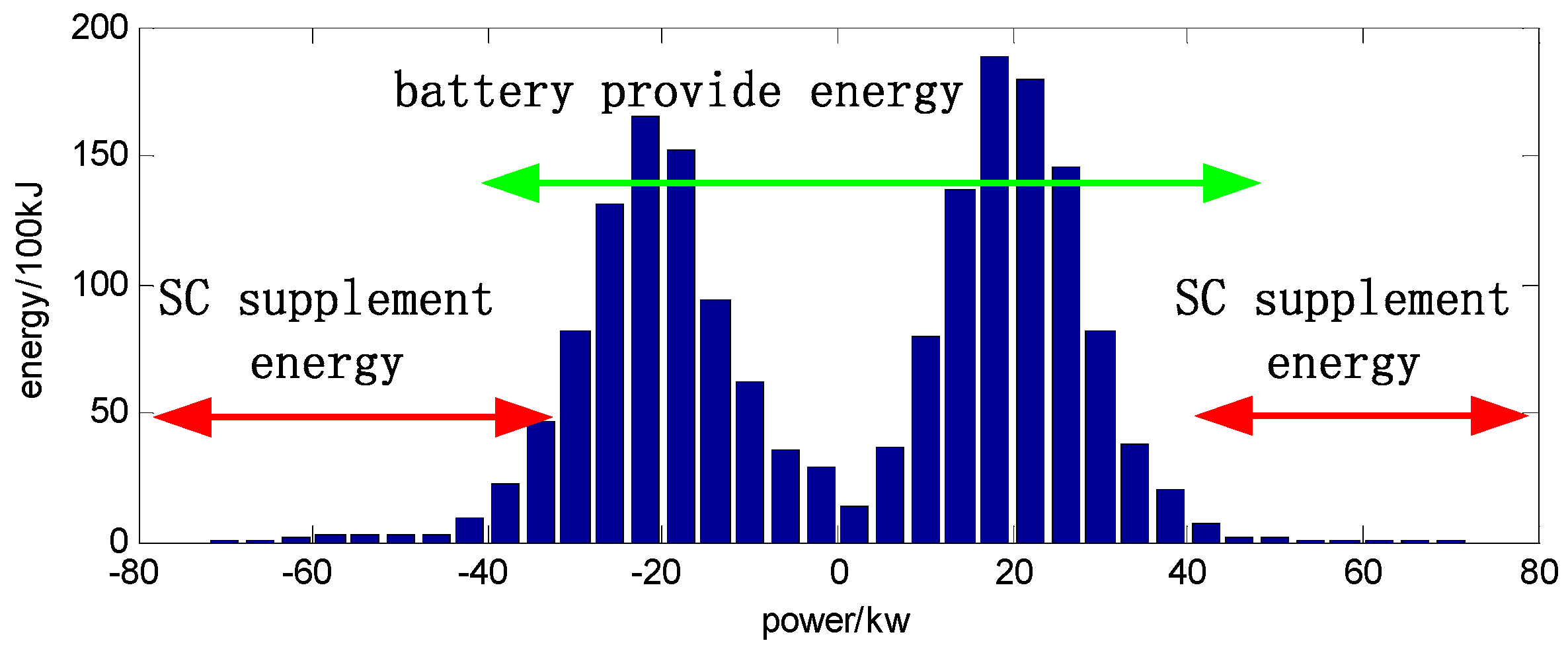


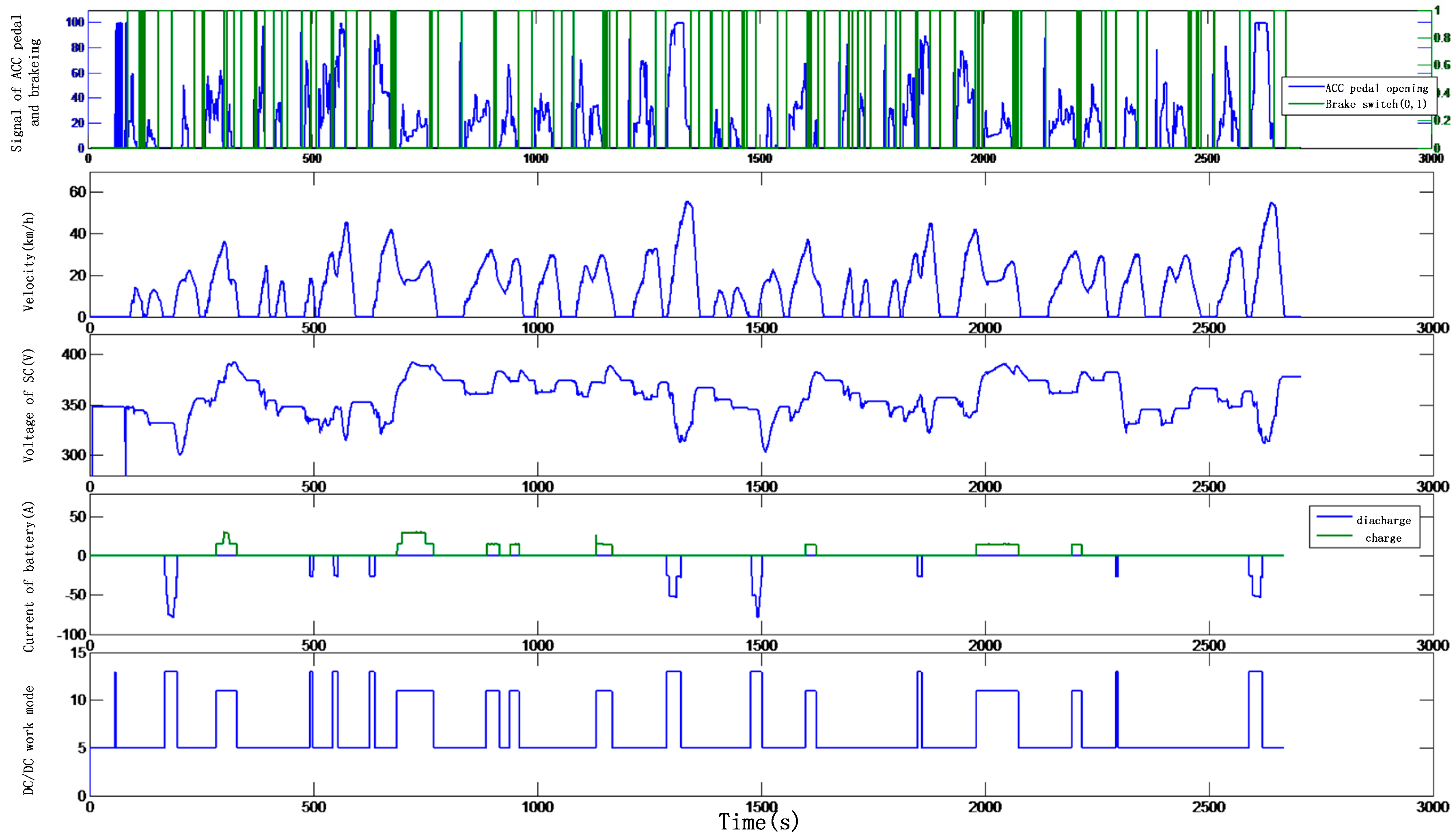
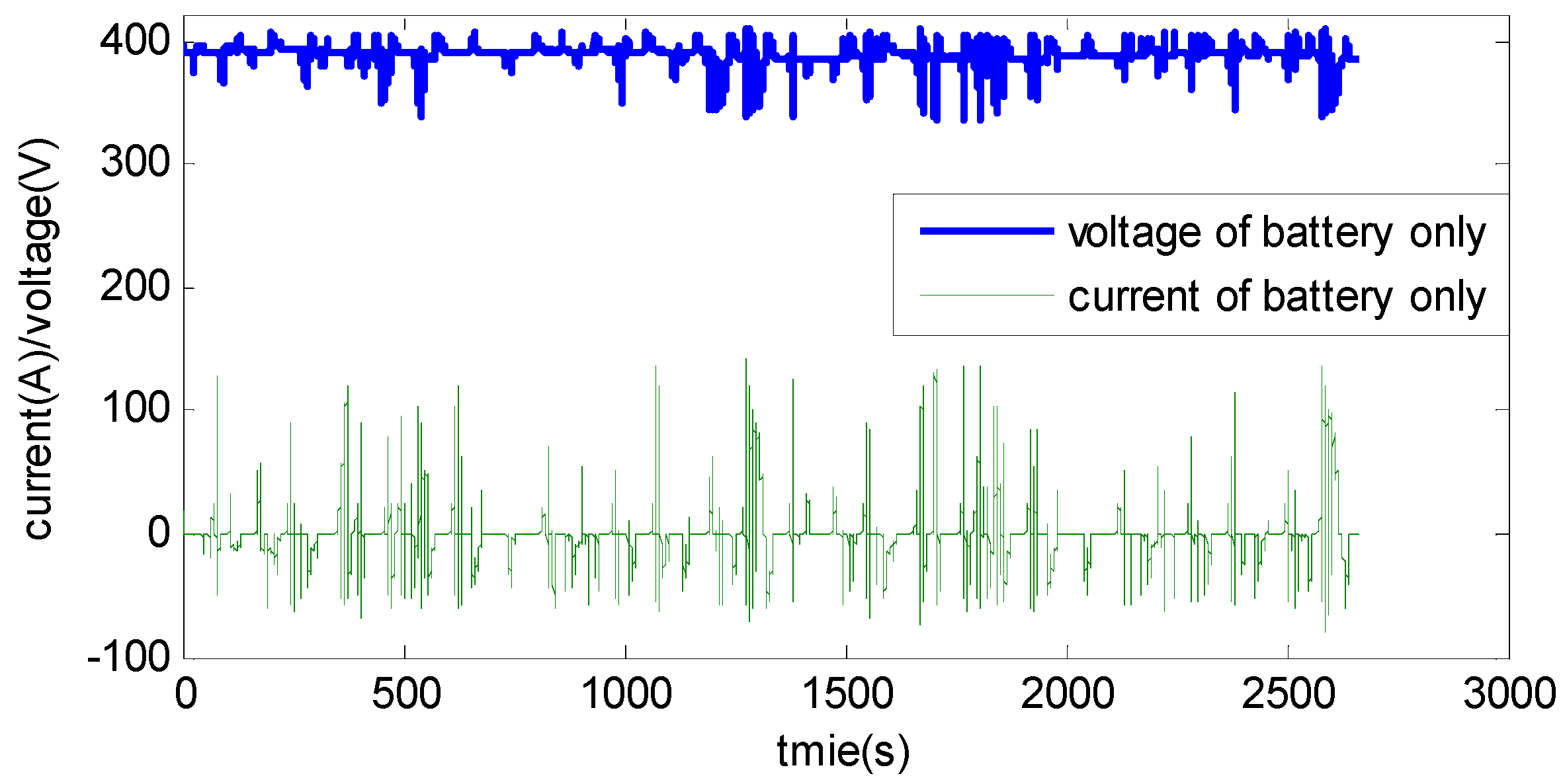
| Parameter | Value |
|---|---|
| Total Mass | 18,000 kg |
| Frontal area | 7.3 m2 |
| Wind resistance coefficient | 0.78 |
| Rolling resistance coefficient | 0.01 |
| Engine | 110 kW |
| ISG/EM | 20/100 kW |
| Statistic Item | Monday | Wednesday | Friday | Saturday | Sunday | Sum | |||||
|---|---|---|---|---|---|---|---|---|---|---|---|
| Driving period (minutes) | 37 | 42 | 40 | 55 | 44 | 42 | 51 | 50 | 45 | 42 | 447 |
| Driving distance (km) | 9.6 | 10.5 | 9.7 | 10.5 | 9.7 | 10.5 | 9.7 | 10.5 | 9.7 | 10.5 | 100.9 |
| Discharging fragments | 59 | 49 | 47 | 81 | 64 | 49 | 53 | 67 | 49 | 56 | 574 |
| Charging fragments | 73 | 66 | 61 | 91 | 75 | 64 | 77 | 74 | 67 | 65 | 713 |
| Parameter | Li-Ion | SC |
|---|---|---|
| Cell Capacity | 8 Ah | 1500 F |
| Internal resistance (mΩ) | 7 | 0.47 |
| Voltage range (V) | 2.5–3.65 | 0–2.7 |
| Weight (g) | 260 | 320 |
| Volume (L) | 0.18 | 0.33 |
| Cost (RMB) | 88 | 180 |
| SOC or voltage range | 0.4–0.6 | 1.9–2.7 |
| Available charging/discharging capacity (Wh) | 25.6 | 1.1 |
| Charging/discharging power limits (w) | 64/128 | 1850 |
| Discharging/charging power mass ratio (w/kg) | 246/492 | 5781 |
| Energy mass ratio(Wh/kg) | 98.5 | 3.33 |
| Discharging/charging power volume ratio (w/L) | 355/710 | 5606 |
| Energy volume ratio (Wh/L) | 142.2 | 3.33 |
| Discharging/charging power cost ratio (w/RMB) | 0.73/14.6 | 10.28 |
| Energy cost ratio (Wh/RMB) | 0.29 | 0.0061 |
| Efficiency Density Parameter | Definition | Unit | |
|---|---|---|---|
| Mass | Ratio of mass to efficiency | The energy loss rate when 1 kg energy source output 1 w | kg/W |
| Volume | Ratio of volume to efficiency | The energy loss rate when 1 L energy source output 1 w | L/W |
| Cost | Ratio of cost to efficiency | The energy loss rate when 1000 RMB energy source output 1 w | 1000 RMB/W |
| Parameters | Battery (8 Ah Cell) | SC (1500 F Cell) |
|---|---|---|
| Ratio of mass to efficiency (%) | 0.0216 | 0.0028 |
| Ratio of volume to efficiency (%) | 0.0170 | 0.0029 |
| Ratio of cost to efficiency (%) | 0.0078 | 0.0016 |
| Parameter | Voltage | Current | ||||
|---|---|---|---|---|---|---|
| High band | 300 V–400 V | 83 A | ||||
| Low band | 150 V–300 V | 167 A | ||||
| Peak power | 25 kW | |||||
| Efficiency Test | Buck Mode | Boost Mode | ||||
| Power in low band/W | 5236 | 10,544 | 15,924 | 7713 | 15,234 | 22,581 |
| Power in high band/W | 5392 | 10,825 | 16,286 | 7471 | 14,849 | 21,947 |
| Efficiency/% | 97.1 | 97.4 | 97.8 | 96.9 | 97.5 | 97.2 |
| Parameter | Value |
|---|---|
| Mass (kg) | 290 |
| Volume (L) | 356 |
| Cost (1000 RMB) | 10.8 |
| Energy provided by battery-only | 13.09 kWh |
| Efficiency | 97.6% |
| Parameter of Two Kinds of HESS | Mass Ratio | Vol Ratio | Cost Ratio | ||||||||
|---|---|---|---|---|---|---|---|---|---|---|---|
| Mass/Volume/Cost ratio of battery to HESS | 25% | 50% | 75% | 25% | 50% | 75% | 25% | 50% | 75% | ||
| Mass/Vol/Cost of battery | 217.5 | 145 | 72.5 | 267 | 178 | 89 | 8.1 | 5.4 | 2.7 | ||
| Mass/Vol/Cost of SC | 72.5 | 145 | 217.5 | 59 | 178 | 267 | 2.7 | 5.4 | 8.1 | ||
| SC/battery (SC as main energy source) | Battery | Energy provided (kWh) | 2.39 | 0.44 | 0.10 | 4.36 | 1.57 | 0.58 | 3.32 | 0.94 | 0.27 |
| efficiency (%) | 98.65 | 97.99 | 95.97 | 98.84 | 97.04 | 94.08 | 98.69 | 98.03 | 96.07 | ||
| SC | Energy provided (kWh) | 10.82 | 12.64 | 12.99 | 8.72 | 11.56 | 12.51 | 9.76 | 11.96 | 12.81 | |
| efficiency (%) | 99.38 | 99.69 | 99.79 | 98.03 | 99.42 | 99.61 | 99.10 | 99.55 | 99.70 | ||
| Total efficiency (%) | 98.74 | 99.53 | 99.74 | 97.31 | 98.79 | 99.24 | 98.24 | 99.23 | 99.56 | ||
| battery/SC (battery as main energy source) | Battery | Energy provided (kWh) | 12.96 | 11.67 | 2.85 | 12.96 | 11.67 | 2.85 | 12.96 | 11.67 | 2.85 |
| efficiency (%) | 97.85 | 96.98 | 96.71 | 96.84 | 95.56 | 95.17 | 97.90 | 97.05 | 96.79 | ||
| SC | Energy provided (kWh) | 0.13 | 1.42 | 10.24 | 0.13 | 1.42 | 10.24 | 0.13 | 1.42 | 10.23 | |
| efficiency (%) | 99.75 | 99.89 | 99.89 | 99.53 | 99.80 | 99.80 | 99.63 | 99.84 | 99.84 | ||
| Total efficiency (%) | 97.84 | 96.97 | 96.85 | 96.84 | 95.7 | 96.45 | 97.89 | 97.03 | 96.83 | ||
| Parameters | SC Package | Battery Package | DC/DC | Total |
|---|---|---|---|---|
| Equivalent Capacity | 18.77 F | 32 Ah | / | - |
| Operating Voltage range (V) | 300–430 | 200–300 | / | - |
| Internal resistance (mΩ) | 37.55 | 120.8 | / | - |
| Available energy for charging/discharging (Wh) | 127.3 | 806.1 | / | - |
| Power limit for charging/discharging (kW) | 206/158.8 | 17.7/35.3 | 25 | - |
| Mass (kg) | 116 | 100 | 22 | 238 |
| Volume (L) | 143.5 | 178 | 34.5 | 356 |
| Cost (1000 RMB) | 50 | 36 | 4.95 | 90.95 |
| ESS of the PTHEB | Energy Usage (kWh/100 km) | Fuel Economy (1/100 km) | Improvement in Fuel Economy | |
|---|---|---|---|---|
| Battery | SC | |||
| SC/battery HESS | 3.41 | 11.03 | 29.4 | ↑7% |
| Battery-only | 10.34 | / | 31.6 | benchmark |
© 2017 by the authors. Licensee MDPI, Basel, Switzerland. This article is an open access article distributed under the terms and conditions of the Creative Commons Attribution (CC BY) license ( http://creativecommons.org/licenses/by/4.0/).
Share and Cite
Min, H.; Lai, C.; Yu, Y.; Zhu, T.; Zhang, C. Comparison Study of Two Semi-Active Hybrid Energy Storage Systems for Hybrid Electric Vehicle Applications and Their Experimental Validation. Energies 2017, 10, 279. https://doi.org/10.3390/en10030279
Min H, Lai C, Yu Y, Zhu T, Zhang C. Comparison Study of Two Semi-Active Hybrid Energy Storage Systems for Hybrid Electric Vehicle Applications and Their Experimental Validation. Energies. 2017; 10(3):279. https://doi.org/10.3390/en10030279
Chicago/Turabian StyleMin, Haitao, Changlu Lai, Yuanbin Yu, Tao Zhu, and Cong Zhang. 2017. "Comparison Study of Two Semi-Active Hybrid Energy Storage Systems for Hybrid Electric Vehicle Applications and Their Experimental Validation" Energies 10, no. 3: 279. https://doi.org/10.3390/en10030279





